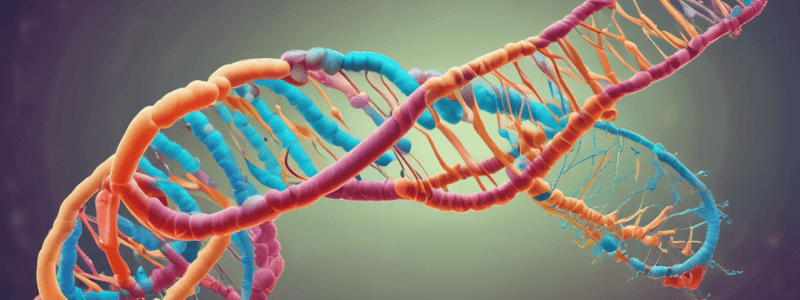Podcast
Questions and Answers
What type of bond holds nucleotides together within an individual DNA strand?
What type of bond holds nucleotides together within an individual DNA strand?
- Hydrogen bond
- Peptide bond
- Glycosidic bond
- Phosphodiester bond (correct)
What is the characteristic of the DNA strands in the double helix structure?
What is the characteristic of the DNA strands in the double helix structure?
- They run in the same direction
- They are perpendicular to each other
- They run in opposite directions (correct)
- They are parallel to each other
How many nucleotide pairs of DNA are present in chromosome 22?
How many nucleotide pairs of DNA are present in chromosome 22?
- 48 million (correct)
- 4.8 million
- 4.8 billion
- 480 million
What is the diameter of the nucleus that holds all the chromosomes?
What is the diameter of the nucleus that holds all the chromosomes?
What is the length of chromosome 22 if it were laid out in one long perfect double helix?
What is the length of chromosome 22 if it were laid out in one long perfect double helix?
Which of the following base pairs is correct?
Which of the following base pairs is correct?
What is the main function of histone modification in chromatin structure?
What is the main function of histone modification in chromatin structure?
During DNA replication, what is the property that allows the double-stranded DNA to be 'pulled apart'?
During DNA replication, what is the property that allows the double-stranded DNA to be 'pulled apart'?
What is the mechanism by which DNA replication occurs?
What is the mechanism by which DNA replication occurs?
What is the role of base complementarity in DNA replication?
What is the role of base complementarity in DNA replication?
What is the significance of histone modification in gene expression?
What is the significance of histone modification in gene expression?
What is the purpose of DNA replication?
What is the purpose of DNA replication?
What is the term for the process by which DNA is wrapped around histone proteins?
What is the term for the process by which DNA is wrapped around histone proteins?
What is the result of histone modification on chromatin structure?
What is the result of histone modification on chromatin structure?
What is the basic structural unit of a chromosome, composed of DNA wrapped around a protein core?
What is the basic structural unit of a chromosome, composed of DNA wrapped around a protein core?
Which of the following is NOT a type of histone protein found in a nucleosome?
Which of the following is NOT a type of histone protein found in a nucleosome?
How does histone modification contribute to the regulation of gene expression?
How does histone modification contribute to the regulation of gene expression?
What is the approximate ratio of DNA to protein in a chromosome?
What is the approximate ratio of DNA to protein in a chromosome?
What is the role of non-histone proteins in chromosome structure?
What is the role of non-histone proteins in chromosome structure?
What is the primary function of the nucleosome?
What is the primary function of the nucleosome?
Flashcards are hidden until you start studying
Study Notes
Protein-DNA Interactions
- Specialised proteins bind to and fold DNA, creating several levels of organisation, such as coils and loops.
- Chromatin refers to a mixture of DNA and proteins that form chromosomes, with each contributing equally to the mass of the chromosome.
Histone Proteins and Nucleosome Structure
- Histone proteins are responsible for the nucleosome, the basic level of chromosome packaging, which has a "bead-like" structure.
- Each nucleosome consists of two of each of the following histones: H2A, H2B, H3, and H4, forming an octamer.
- Double-stranded DNA winds around the octamer.
Base Pairing and DNA Structure
- Guanine pairs with cytosine, and adenine pairs with thymine.
- Nucleotides within an individual strand are bonded by strong covalent bonds (phosphodiester bonds).
- Nucleotides between individual strands are held together by weaker hydrogen bonds.
- The famous double helix structure is formed by the two strands running in opposite directions (anti-parallel).
- DNA is highly condensed in chromosomes, with about 48 million nucleotide pairs in chromosome 22, which would stretch out to about 1.5 cm in length if laid out in a perfect double helix.
Histone Modification and DNA Accessibility
- Histones can be modified through post-translational mechanisms (e.g. acetylation, phosphorylation) to alter the accessibility of DNA, influencing gene expression and protein production.
DNA Replication and Genetic Inheritance
- All cells replicate their DNA through templated polymerisation, ensuring the accurate copying of genetic information.
- DNA replication relies on base complementarity (e.g. G-C and A-T) and occurs in a semi-conservative manner, with new strands synthesised against a template (old strand).
- The separation of the double-stranded DNA allows each individual nucleotide on each individual strand to be recognised by a free (unpolymerised) nucleotide.
Studying That Suits You
Use AI to generate personalized quizzes and flashcards to suit your learning preferences.



